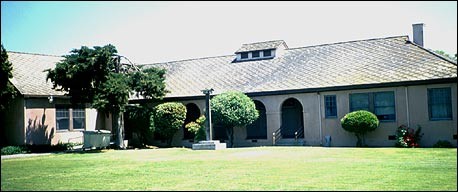Gakuen Hall
Introduction
Text-to-speech Audio
Walnut Grove and surrounding communities had large and growing Asian American populations. Following a 1921 law mandating segregation of Asian American children, Isleton, Courtland, Walnut Grove, and other communities in California maintained segregated “Oriental” schools. At the same time, privately-operated schools that preserved Japanese language and culture found themselves under attack as well. Gakuen Hall was a Japanese language school built by Japanese immigrants in 1927 in order to offer an alternative to the state-operated schools. The school was also part of the Japanese-American community's attempt to maintain their language and culture in America.
Images
Gakuen Hall

Backstory and Context
Text-to-speech Audio
In the 1910s, many white Americans throughout Hawaii and on the West Coast expressed anger about the presence of Japanese children in public schools. They were also outspoken opponents of privately-operated Japanese language schools. Native-born Americans were fearful that such schools prohibited Japanese-Americans students from fully assimilating into American life and adopting American customs, and yet, they also opposed full integration and even supported measures to create separate schools for children of Asian immigrants. Years later, during World War II, when thousands of Japanese-Americans were forced into internment camps, teachers and administrators were among the first to be detained.
As the Japanese population of California increased, so did anti-Japanese sentiment and efforts to contain the perceived threat posed that population. In 1921, the Parker Bill was passed, which placed Japanese language schools under the authority of the Superintendent of Public Instruction. Instructors at the schools were required to be proficient in the English language and to have knowledge of American history. They were also required to pledge to work to make Japanese-American students good American citizens.
At the time, Walnut Grove had a Japanese population, most of which was concentrated in the neighborhood known as Japantown. Walnut Grove was known as Kawashimo, and its Japantown flourished, although most of the land and businesses in the area were owned by a few white residents. Japantown was home to a number of businesses and institutions that catered to Japanese-Americans, including a Buddhist temple.
Another institution located in Japantown was Gakuen Hall, a Japanese language school. Gakuen Hall is the only known example of a Japanese language school built by Japanese themselves in response to segregated schools.During World War II, when Japanese-Americans were interned, the building was held in trust by a local landowner until Walnut Grove's interned residents returned.
Gakuen Hall is listed on the National Register of Historic Places, as is the Walnut Grove Japanese-American Historic District.
As the Japanese population of California increased, so did anti-Japanese sentiment and efforts to contain the perceived threat posed that population. In 1921, the Parker Bill was passed, which placed Japanese language schools under the authority of the Superintendent of Public Instruction. Instructors at the schools were required to be proficient in the English language and to have knowledge of American history. They were also required to pledge to work to make Japanese-American students good American citizens.
At the time, Walnut Grove had a Japanese population, most of which was concentrated in the neighborhood known as Japantown. Walnut Grove was known as Kawashimo, and its Japantown flourished, although most of the land and businesses in the area were owned by a few white residents. Japantown was home to a number of businesses and institutions that catered to Japanese-Americans, including a Buddhist temple.
Another institution located in Japantown was Gakuen Hall, a Japanese language school. Gakuen Hall is the only known example of a Japanese language school built by Japanese themselves in response to segregated schools.During World War II, when Japanese-Americans were interned, the building was held in trust by a local landowner until Walnut Grove's interned residents returned.
Gakuen Hall is listed on the National Register of Historic Places, as is the Walnut Grove Japanese-American Historic District.
Sources
Walnut Grove. California Japantowns. Accessed August 27, 2017. http://www.californiajapantowns.org/walnutgrove.html.
